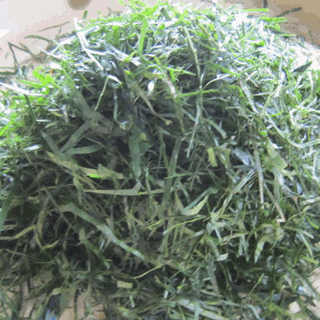AFANG LEAF (ERU)
- Chef Bwizzy
- Apr 27, 2017
- 2 min read

SCIENTIFIC NAME: Gnetum africanum
OTHER NAMES: Nigeria – Okazi/Ukazi (Ibo), Afang (Ibibio & Efik) Cameroun - Eru, Okok, M’fumbua or Fumbua Angola, Congo & Central African Republic – Koko
Afang leaf widely known as Eru or African Jointfir is a dark green leafy vegetable found natively throughout tropical Africa. It is also referred to as a form of “wild spinach” in English. It is a wild vine and is considered a wild vegetable. It has a thick papery-like leaves growing in groups of three. The seeds resembles a fleshy fruit and are red-orange in color when fully ripe.
Eru may also be known as G. africanum or G. buchholzianum, and are the only two vine species from the gnetum family. It is mainly in the humid tropical forest regions of Central African Republic, Cameroon, Gabon, Democratic Republic of the Congo and Angola. The shade tolerant vine does not grow well in direct sunlight and can be found climbing on middle and under-story trees. Therefore, Eru grows well in shaded areas. In Nigeria, it is cultivated locally by small farmers.
The eru leaves can be used for medicinal purposes as well as edible consumption purposes too. They can be eaten raw or used to make soups and stews. The most common soup prepared with this vegetable is the eru soup or afang soup. The root produces a tuber that can be consumed as yam and the seeds can be eaten cooked.
NUTRITIONAL VALUES
• It is a good source of protein. It has strong essential and non-essential amino acids.
• It is high in glutamic acid, leucine, and aspartic acid, with low levels of histidine, and cysteine.
• Leucine aids the production of growth hormone and lowers blood sugar level. Leucine with Isoleucine and valine are required for energy production. It is needed for proper regulation of protein metabolism.
• Glutamic acid is important for brain function. It is involved in the metabolism of ammonia. It assists in the treatment of alcoholism.
• Aspartic acid supports brain and neurological functions as well as liver function. It increases stamina.
• It’s levels of iodine are also high. This is necessary for the proper function of the thyroid gland and prevent goitre.
• It is an anti-inflammatory, anticarcinogenic and antioxidant.
• It is an excellent source of unsaturated fatty acids. Unsaturated fats make up HDL (good cholesterol).
• It’s Dietary fiber levels average approximately 33.4 g/100 g of dried Eru leaves while the recommended daily intake of fiber is 30 g. This is good for weight loss and helps prevent constipation. Dietary fibres also prevents colon cancer.
HEALTH BENEFITS
• The leaves can be used as a remedy for nausea, sore throat and can be used for a dressing for warts.
• The stem can be eaten to help reduce pain during childbirth.
SWIT KITCHEN’S NOTE: Remember too much of everything is bad. Eat in moderation. Not too much and not too little. #Balanceyourlife
















Comments